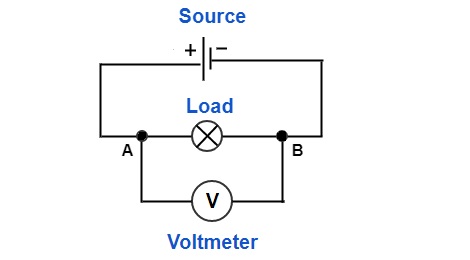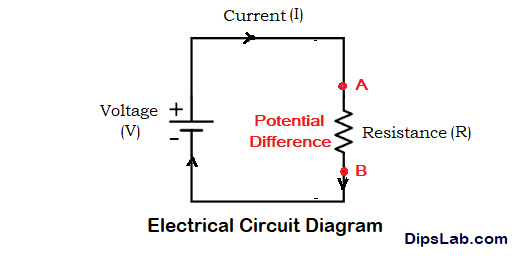
What do you think about the voltage, potential difference, and EMF?
Actually, many of us are confused about these three terms. Sometimes we think that these are the same. If these three terms are the same, why there are three different names?
These are very basic terms in Electrical and Electronics Engineering. If you understand it properly, it will help you throughout engineering.
In this post, I am explaining voltage, potential difference, and electromotive force (EMF). Let’s see if they are the same or different.
What is Voltage?
In the practical study, voltage is called as ‘Pressure (P)’ or ‘Tension (T)‘.
Definition
Here is my simplified basic definition of voltage so that everyone can understand it.
When a potential is provided through the electrical power source, it pushes electrons easily. This potential is called as the ‘Voltage‘.
The technical definition of the voltage is –
Voltage is the potential energy requires to flow the electric current (or electrons) in an electrical circuit.
If we talk about electrical equipment, the potential energy is provided in the form of the cell or battery.
The cell or battery is an electronic device that stores chemical energy and transfers into electrical energy.
What is the difference between Cell and Battery?
The cell is a single DC (Direct Current) power generating unit. And battery consists of two or more electrochemical cells for generating more DC power.
You can see the block diagram of the energy conversion system below.

Block Diagram for the Battery Conversion
The symbolic representation is different for cells and batteries.

Call Symbolic Representation with Voltage

Battery Symbolic Representation with Voltage
Symbolic Representation of Voltage for DC and AC
Voltage is represented by the capital letter ‘V’.
The symbolic representation of the direct current and alternating current sources are shown in the below diagram.
- For DC Source

Direct Current (DC) Voltage Source Symbol
- For AC Source

Alternating Current (AC) Voltage Source Symbol
Voltage Formula
We can calculate the value of the voltage or potential difference by using the basic formula.
Voltage, (V) = (Electric Potential Energy / Electric Charges) (Unit- Volt)
It means that the voltage measured is the electrical potential energy per unit charge.
Where,
- Electric Potential energy (W) is expressed in Joule (J).
- Electric charge particle (Q) are expressed in Coulomb (C).
You can also put it in another format. If you are knowing the current and resistance, you can calculate the voltage.
Voltage, (V) = (Current * Resistance) (Unit- Volt)
Where,
- Current (I) is expressed in Ampere.
- Resistance (R) is expressed in ohm.
Measurement of the Voltage
The voltage is expressed in ‘Volt’. There are electrical types of equipment to measure the voltage called as a ‘Voltmeter’ or ‘Multimeter’.
Why it is called as Volt?
If you look at history, it’s a bit interesting.
In 1745 – 1827, Italian physicist Alessandro Volta has invented the first electrical Voltaic pile battery. The unit of the voltage-Volt is derived from his name.
To calculate the voltage in any electrical circuit, you have to connect a voltmeter in a parallel position. (You can read the difference between series and parallel circuits.)
You can see the following figure where the voltmeter is connected across the terminal of the load.

A voltmeter connected in parallel across the load
A voltmeter is just one equipment. There are many Electrical Measuring Instruments you should be knowing.
Calculating Voltage using Ohm’s and Kirchhoff’s Laws
Here are two basic formulas you can use to calculate the voltage in electrical circuits.
- Ohm’s Law
According to ohm’s law, voltage is the product of the electric current and resistance. You can calculate the value of the voltage by putting current and resistance values.
Voltage, (V) = (Current * Resistance) = (I * R) (Unit- Volt)
- Kirchhoff’s Law
According to Kirchhoff’s Voltage Law (KVL), the different voltage or equivalent voltage can be determined in a circuit.
Total Voltage, Ʃ(V) = (V1 + V2 + V3 + V4 +........ + Vn) (Unit- Volt)
Online Tool for Calculating Voltage
You can be calculated the value of voltage by using simple online tools.
[CP_CALCULATED_FIELDS id=”8″]
[CP_CALCULATED_FIELDS id=”21″]
Now you don’t have to bother about going wrong while doing the mathematical calculations.
This is a simple explanation. I tried to sum up all the basics of electrical voltage.
Let’s move to our other term- Potential Difference.
What is the Difference between Voltage and Potential Difference?
Voltage and potential difference both are similar for their use of flowing charged particles. But, both works in different aspects.
Potential difference is shortly denoted by the ‘PD’.
Simple definition.
Potential difference defines as the potential energy requires to move or transfer the unit of the electric charge or current from one place to another in between two terminals of the electrical field.
According to the definition, it is represented as
Potencial Difference = (Energy or Work / Charge) (Unit- Joule/Coloumb or Volt)
The S.I. unit of the potential difference and the voltage are the same. Both are measured in voltmeter.
Lets we will study,
How does the potential difference work in the circuit?
In the given diagram, the electric circuit consists of the voltage source (battery) and resistive load.
You can connect different types of an ideal and practical voltage source.

The positive terminal of the battery has a higher potential and the negative terminal of the battery has a lower potential. Both ends of the terminal are connected with the resistive load to complete the closed-loop circuit.
When the electric current passes through the resistive load, the voltage changes between two terminals. This changing voltage is called as a ‘Voltage Drop’.
The energy is required to flow of electric current from higher potential (point A) into lower potential (point B). In between two given points, the occurring voltage is called a potential difference.
What is the Difference Between Voltage and EMF (Electromotive Force)?
EMF is nothing but the force. It is another form of energy.
It is shortly abbreviated as the ‘EMF‘ or ’emf‘ or ‘E’.
The energy is necessary to move the free electron and to produce an electric current through a particular direction in a closed circuit. This energy called ‘Electromotive Force’.
The EMF is denoted by (cursive letter E) ‘ε’. The S.I unit of the EMF is Volt.
Function:
The main function of the EMF is to,
- maintain the potential difference
- produce electrical energy from the non-electric source
Multiple electrical devices are used to generate EMF such as electrochemical cells, solar (PV) cells, electrical motor and generators, transformers, etc.
This is an explanation about the voltage, potential difference, and electromotive force. Hopefully, you understood it very well now.
If you have any queries, you can freely comment below.
Read more related articles:
- Anode vs Cathode
- Power vs Energy
- Capacitor vs Battery
- Resistance vs Reactance
- Conductor vs Insulator
- Active Component vs Passive Component
- Electromotive Force vs Magnetomotive Force
Thanks for Reading!
Hi, I just wanted to say, I loved this blog post.
It was inspiring. Keep on posting!
Thank you, Mick:)
Thank you
Welcome 🙂
Great methodology
It’s actually a helpful piece of information. I am glad that you just shared this useful information with us.
Please, keep us informed like this. Thanks for sharing.
Thanks, Mohmad for giving feedback and sharing your own experience.
And I am promising that, I will share the more useful and updated post on DipsLab.
Good Explanation, Mam.
Thanks, Shubham 🙂
Very well explanation, Mam.
Thanks, Jagdip 🙂
Thanks for one’s marvelous posting!
You’re welcome, Sejal 🙂
I really like your writing style, good information, thank you for putting up :D.
Thanks, Sairina 🙂
Thank you, Mam.
You’re welcome, Dear 🙂
Thanks, William for reaching out to my blog. And I feel very glad to hear this sound.
Hi Dipali, I visit your website on regular basis to get updated on the most recent information. Great job!
Thanks, Parber to reach out to my blog and find out daily update.
Thanks to share.
It’s my pleasure to share my experience on DipsLab 🙂